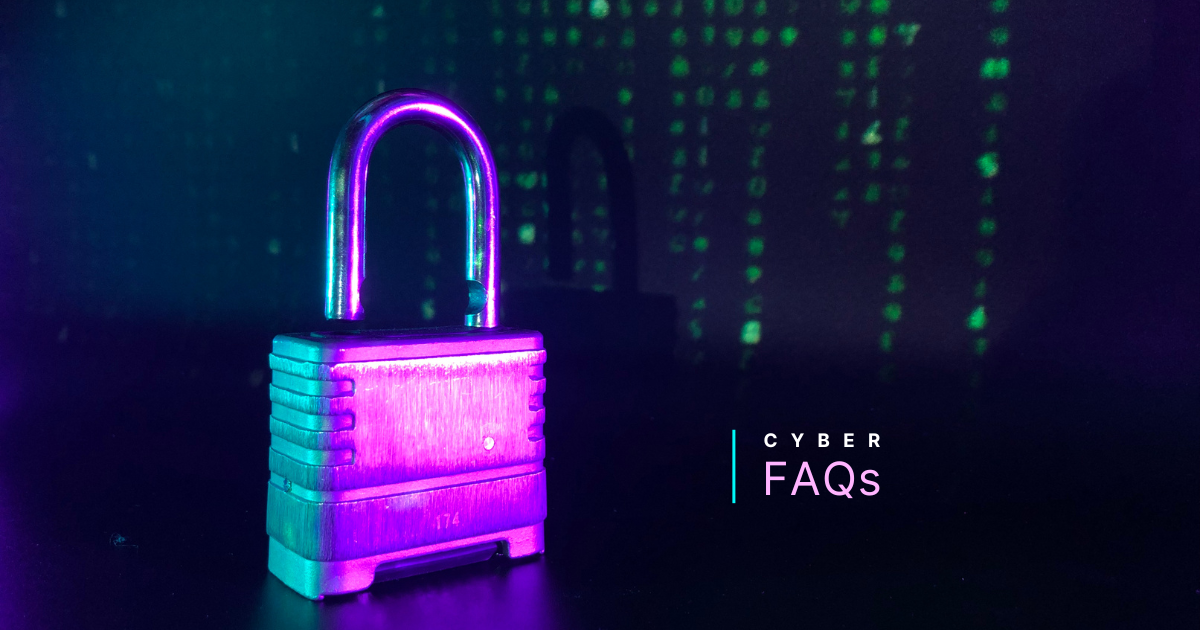
Q: What Is Cybersecurity?
Just like you’d protect your home with house security (locks, gates, doors), cybersecurity protects your business from malicious (and accidental) attacks through your internet-connected networks, computers, mobile devices, software, and applications. These cybersecurity measures are designed to defend against attackers seeking to gain access to your data, destroy, or extort sensitive customer information, or get you to pay funds into a false account. Good examples of cybersecurity measures include strong passwords, two factor authentication, staff education and pre-prepared disaster recovery plans.
Q: What is a data breach?
A data breach is when an intruder gets unauthorized access to your information such as customer records and personal information, intellectual property, or company secrets. It’s often a PR nightmare having to inform the customers and suppliers that you, and maybe their data, has been stolen.
Q: What is malware?
Malware is named from ‘malicious software’, where software has been installed on your computer or network without you knowing and tries to disrupt your business. It could be executable code, computer viruses, worms, trojans, bots, spyware, ransomware, or other malicious programs. Often picked up when installing or clicking on links you or an employee shouldn’t.
Q: What is a phishing email?
Phishing is when someone disguised as a trusted contact or source tries to defraud you, often through email, text message or social media contact. Attackers try to get personal data such as passwords or bank/credit card numbers by hoping that you’ll click on fake links to sites or open attachments which install malware or direct you to pay an invoice or amount owed to a fake bank account.
Q: What are business email compromise hacks?
Business email hacking involves someone gaining access to an employee’s business email account so they can pose as the employee, to then trick others into fraudulent wire transfers, gift card purchases or other financial transactions. Often, the hack involves the attacker impersonating the business owner, but can include pretending to be a supplier requesting you user a new bank account for your latest purchase.
Q: What is ransomware?
Ransomware is when you’ve mistakenly installed a rogue piece of software (from clicking on a link or opening an attachment), giving access and control of your systems to an attacker, who then demands money. If you don’t pay (usually by an untraceable currency such as Bitcoin), the attacker will delete your data, or lock your screens and deny you access.
Q: What is scareware?
Scareware is like ransomware, this time threatening to swamp you with annoying notifications, reveal your online behavior (real and not real) or threaten you with consequences, like a tax audit.
Q: Do I need cyber insurance?
Cyber-risk insurance depends on your risk profile. You’re less likely to need it (or not as much cover) if you have robust cybersecurity protection, good awareness with staff and a well-defined process for restoring business systems. But every time your business connects to the Internet, you expose it to potential hackers, so cyber cover protects you from financial loss and can cover you for claims if your use of the Internet caused someone else to suffer a loss.
Q: How do I write a digital disaster plan?
First, list all the things you have connected to the internet (servers, desktops, laptops, phones etc.) and wireless devices), and outline how you keep these safe (passwords and back-up for example), then all the data and mission critical software you can’t do without. Once you’ve identified the assets and data you want to protect, next to each, outline what you do to keep hackers out (passwords, two-factor authentication, staff training, etc.) and what you’ll do if that fails (back-up and system recovery). Then test to make sure it all works. Check out our Cyberattack Recovery Guide for more details.
Q: What is two-factor authentication?
Two-factor authentication (or 2FA) is when you are asked for one more security step before getting access to what you have logged into. Often, it’s an email or a text asking you to enter a code or confirm you logged in, to prove that it’s you at the other end. These codes are randomly generated at the moment they’re required, often only valid for one use and usually time-out if not used within a certain, short, period of time.
Q: What is three-factor authentication?
Three-factor authentication (3FA) is even more secure and usually needs three different types of security, typically, knowledge (something you know, like a PIN, username or password), possession (something you have with you, like a phone that gets sent a one-time password, a key fob or ID card) and inherence (something biological, such as a finger print, retina or voice recognition).
Q: How do I know I’ve been hacked?
It’s not always obvious, but some common hints you’ve been hacked include an inability to log in to an account, unknown program opening when starting your computer, pop-up windows, lots of spam emails, social media posts appearing that you didn’t write or your computer isn’t performing as it usually does (slowed down or crashes more frequently).
Q: What’s the best way to back up my data?
There are multiple ways to back-up your data, the easiest is to copy everything to a USB stick or burn to a CD or DVD but it’s not always practical with large amounts of data. You can back up using cloud storage services like Google Drive and Dropbox, but they’re more to sync files across devices than a pure back-up especially if you need to save terabytes of stuff. Experts often recommend the 3-2-1 rule: three copies of your data, two local (on different devices) and one off-site. For most people, this means the original data on your computer, a backup on an external hard drive, and another on a cloud backup service.
Q: Who can help me with practical cybersecurity advice?
If you have internal staff or an external IT provider that manages your cybersecurity then great, otherwise try resources like https://www.fbi.gov/investigate/cyber to access information on potential or real-time cyber-attacks. Use the Two Factor Directory to check what IT services use 2FA, which is a recommended pre-requisite for accessing critical data.
Q: Who do I contact if I’ve been hacked? The police, someone else?
First, if you’ve been hacked, get it fixed! Either your in-house or external IT support person. If you don’t have anyone, there are lots of consultants and IT support businesses you can call. Then report it to the FBI’s Internet Crime Complaint Center (or ‘IC3’) at https://www.ic3.gov/. Other people to tell include staff, customers and anyone else that supports your business (bank, accountant, business colleagues).
You can also contact your local FBI field office to report the crime and file a complaint with the FBI’s Internet Crime Complaint Center (IC3).
Q: What is a denial of service?
A denial-of-service is when your computer/laptop or your network crashes because someone or something has flooded your devices with unwanted traffic or information. It literally denies you access to the internet and your data, with the attack typically consuming all your hard disk space, memory or server capacity. Usually, the attacker demands money in exchange for ceasing their attacks, calculating the financial and reputational damage of you being shutdown is worse than the ransom.
Disclaimer: The information provided in this content is for general educational purposes only and does not constitute professional advice. Locality Bank makes no warranty, express or implied, nor assumes any legal liability or any responsibility for the accuracy, correctness, completeness, or any actions taken based on the information provided. Always consult a qualified professional for specific guidance related to your situation.


